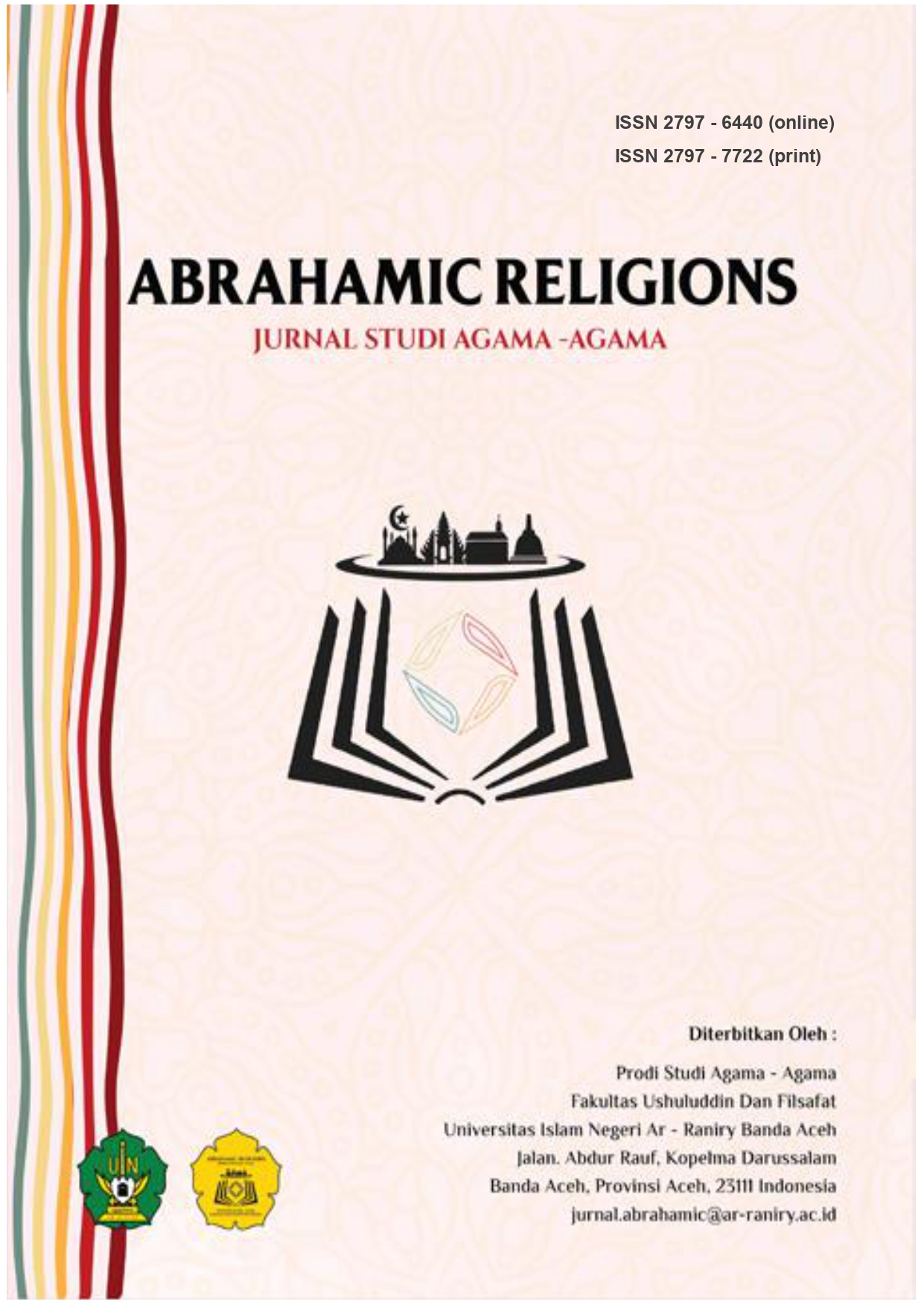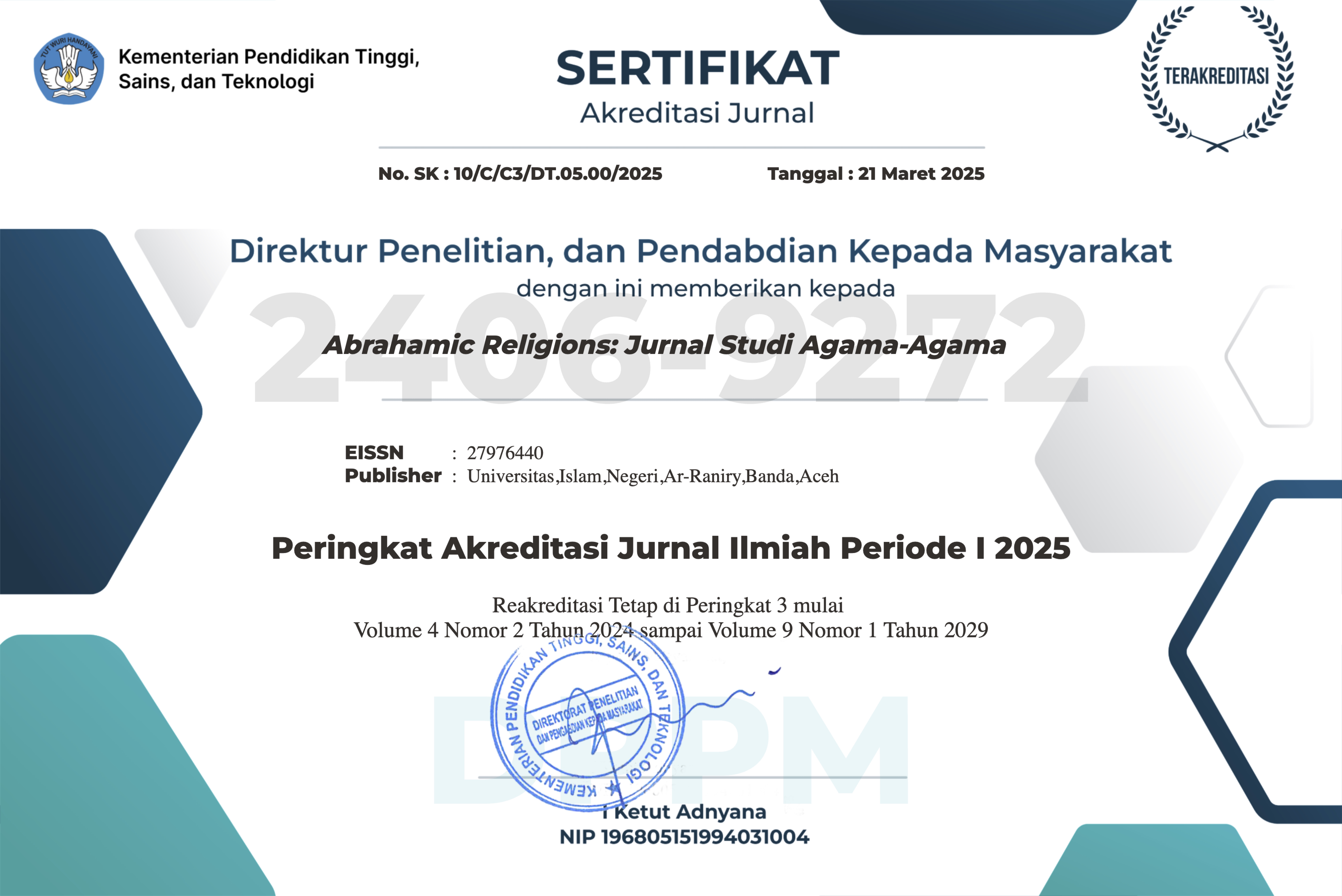Torah sebagai Kitab Suci Yudaisme: Konsep dan klasifikasi
DOI:
https://doi.org/10.22373/arj.v3i1.15049Keywords:
Yudaisme, Kitab Suci, Tanakh TorahAbstract
Scripture is one of the essential parts of every religion, as from scripture, people can understand many things related to the belief in question, such as the concept of divinity, teachings, rituals, laws and regulations, and many others. Likewise, Jews own Torah which was revealed to the prophet Moses. In addition, there are also other books that they believe in the life of Jews. This study aimed to determine the definition, meaning, and classification of Torah according to Judaism. Accordingly, this study used a descriptive analysis method through a qualitative approach with literature studies to sufficiently understand the intended research purpose. This study concluded that Torah is Jews guideline of life, containing divine laws taught to Moses and transmitted to further generations. Torah, in detail, encompasses five books: Bereshit, Shemot, Vayiqra, Bemidbar, and Devarim.
ABSTRAK
Agama yang diyakini setiap umat memiliki Kitab Suci sebagai salah satu bagian penting dari setiap agama, oleh karena dari kitab suci orang dapat memahami banyak hal yang berkaitan dengan kepercayaan terkait, seperti konsep ketuhanan, ajaran, ritual, hukum dan peraturan, dan banyak lainnya. Pun demikian umat Yahudi juga memiliki Torah yang diturunkan kepada Musa. Selain Torah, ada juga kitab-kitab lain yang mereka yakini mendeskripsikan kehidupan orang Yahudi. Penelitian ini bertujuan untuk mengetahui definisi, makna, dan klasifikasi Torah menurut Yudaisme. Guna mencapai itu, penelitian ini menggunakan metode analisis deskriptif melalui pendekatan kualitatif dalam bentu studi pustaka untuk mampu menjawab tujuan penelitian yang dimaksud. Penelitian ini menyimpulkan bahwa Torah adalah pedoman hidup orang Yahudi, berisi hukum-hukum ketuhanan yang telah diajarkan kepada Musa dan diturunkan kepada generasi selanjutnya. Torah, secara detail mencakup lima kitab: Bereshit, Shemot, Vayiqra, Bemidbar, dan Devarim.
References
Ashley, T. R. (1993). The Books of Numbers. Wm. B. Eerdmans Publishing.
Bandstra, B. L. (2009). Reading the Old Testament: An introduction to the Hebrew Bible (4th ed). Wadsworth/ Cengage Learning.
Bergant, D. (2013). Genesis: In the Beginning. Liturgical Press.
Berlin, A., Brettler, M. Z., & Fishbane, M. A. (Ed.). (2004). The Jewish Study Bible: Jewish Publication Society Tanakh Translation. Oxford ; New York : Oxford University Press.
Birnbaum, P. (1979). Encyclopedia of Jewish Concepts. New York : Hebrew Pub. Co. http://archive.org/details/encyclopediaofje0000birn
Blenkinsopp, J. (2011). Creation, Un-creation, Re-creation: A Discursive Commentary on Genesis 1-11. A&C Black.
Bräunlein, P. J. (2016). Thinking Religion Through Things: Reflections on the Material Turn in the Scientific Study of Religions. Method & Theory in the Study of Religion, 28(4–5), 365–399. https://doi.org/10.1163/15700682-12341364
Brink, T. L. (1995). Quantitative and/or Qualitative Methods in the Scientific Study of Religion. Zygon®, 30(3), 461–475. https://doi.org/10.1111/j.1467-9744.1995.tb00084.x
Campbell, A. F. (1993). Sources of the Pentateuch: Texts, introductions, annotations. Fortress Press. http://archive.org/details/sourcesofpentate0000camp
Elster, C. A. (2003). Authority, Performance, and Interpretation in Religious Reading: Critical Issues of Intercultural Communication and Multiple Literacies. Journal of Literacy Research, 35(1), 663–692. https://doi.org/10.1207/s15548430jlr3501_5
Gorman, F. H. (1997). Divine Presence and Community: A Commentary on the Book of Leviticus. Wm. B. Eerdmans Publishing.
Gschwandtner, C. M. (2019). What is phenomenology of religion? (Part I): The study of religious phenomena. Philosophy Compass, 14(2), e12566. https://doi.org/10.1111/phc3.12566
Hoenig, S. B. (1963). Circumcision: The Covenant of Abraham. The Jewish Quarterly Review, 53(4), 322–334. https://doi.org/10.2307/1453385
Kitchen, K. A. 1932-. (1995). The Patriarchal Age. Myth or History? Biblical Archaeology Review, 21(2).
Leveen, A. (2012). Memory and tradition in the book of Numbers. Cambridge University Press.
McDermott, J. J. (2002). Reading the Pentateuch: A Historical Introduction. Paulist Press.
McDonald, L. M. (2012). Formation of the Bible: The Story of the Church’s Canon. Hendrickson Publishers.
Meyers, C. (2005). Exodus. Cambridge University Press.
MSF, A. P. H. (2022). Katekese Pokok dalam Lima Kitab Musa. PT Kanisius.
Neusner, J. (2006). Judaism: The Basics. Routledge.
Nida, E. A. (2007). The Sociolinguistics of Translating Canonical Religious Texts. TTR : Traduction, Terminologie, Rédaction, 7(1), 191–217. https://doi.org/10.7202/037173ar
Olson, D. (1996). Numbers. Westminster John Knox Press.
Paterson, R. M. (1994). Tafsir Alkitab Kitab Imamat. BPK Gunung Mulia.
Paterson, R. M. (2006). Tafsir Alkitab Kitab Keluaran. BPK Gunung Mulia.
Phillips, A. (1974). Deuteronomy. CUP Archive.
Ska, J.-L. (2006). Introduction to Reading the Pentateuch. Eisenbrauns.
Sommer, B. D. (2015). Revelation and Authority: Sinai in Jewish Scripture and Tradition. Yale University Press.
Stefon, M. (Ed.). (2011). Judaism: History, Belief, and Practice. The Rosen Publishing Group, Inc.
Stuart, D. K. (2006). Exodus. B&H Publishing Group.
Sweeney, M. A. (2012). Genesis in the Context of Jewish Thought. Dalam C. A. Evans, J. N. Lohr, & D. L. Petersen (Ed.), The Book of Genesis: Composition, Reception, and Interpretation. BRILL.
The Holy Bible, New King James Version. (1982). Thomas Nelson Publishers.
Weinstein, J. (1997). Exodus and Archaeological Reality. Dalam E. S. Frerichs & L. H. Lesko (Ed.), Exodus: The Egyptian evidence. Eisenbrauns. http://books.google.com/books?id=ObnYAAAAMAAJ
Wenham, G. J. (1979). The Book of Leviticus. Grand Rapids, Mich. : W.B. Eerdmans. http://archive.org/details/bookofleviticus0000wenh
Zeligs, D. F. (1961). Abraham and the Covenant of the Pieces: A Study in Ambivalence. American Imago, 18(2), 173–186.
Downloads
Additional Files
Published
Issue
Section
License
Authors who publish in this Journal agree to the following terms:
- Authors retain copyright and grant the journal right of first publication with the work simultaneously licensed under Attribution-ShareAlike 4.0 International (CC BY-SA 4.0) allows others to share the work with an acknowledgment of the work's authorship and initial publication in this journal.
- Authors are able to enter into separate, additional contractual arrangements for the non-exclusive distribution of the journal's published version of the work (e.g., post it to an institutional repository or publish it in a book), with an acknowledgment of its initial publication in this journal.
- Authors are permitted and encouraged to post their work online (e.g., in institutional repositories or on their website) prior to and during the submission process, as it can lead to productive exchanges, as well as earlier and greater citation of published work. (See The Effect of Open Acces)















